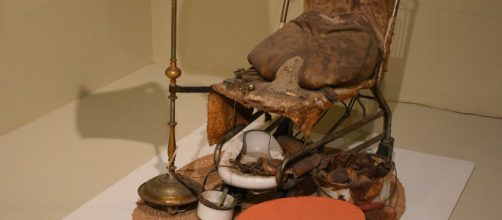A July 3 article in the L.A. Times raised an unintended question. Headlined “As Roe vs. Wade is overturned, a grim 1962 sculpture gains tragic new relevance,” My question: is it a sculpture or a cluster of cast-off objects?
Off message
Of course, one could easily argue that my question is out of place at a time when five Catholics in black robes forbid abortion in a secular nation. Does differentiating between sculpture and a cluster of readymade objects matter in the face of such a ruling?
Naturally, I’m torn. Taking away women’s rights is the mattering issue at the moment, not “art.” Still, the art question nags.
Does one only ask the what-is-art question when there’s nothing else to talk about? Is art-talk like a dessert that you indulge in only after you eat your vegetables?
I’d probably let the question go for another time if the L.A. Times story about this “sculpture” wasn’t written by the Times' longtime art critic, Christopher Knight, who skipped over any art question and went straight to the political issue of the day. Understandable given the issue. But then, who’s minding the store - the art integrity store?
The “art” in question, “Illegal Operation,” was assembled by Edward Kienholz in 1962 after his wife suffered an illegal abortion. As Knight rightly said, Kienholz’s piece “gave intense visual form” to the back-alley procedure.
The Los Angeles County Museum of Art, owner of “Illegal Operation,” describes its materials like a shopping list without comment. So you don’t get the squalidness of this thing. Knight doesn’t mince words, calling it "sordid in every detail," from used bedpan to filthy rags.
Is it art?
But the vilest detail of all is the symbol of a woman as a gray, ruptured bag of oozing matter on the seat.
Horrible? Yes. Art? Knight invoked the word twice. The first time, he called this cluster of readymade objects “a work of art" that makes real the horrible procedure done to "desperate women.”
In the second instance, Knight noted how the cluster of readymade objects represented the misogynistic brutality we all thought had ended.
“Art defining the present became an artifact of the past,” he said.
Fitting that description is another assemblage of readymade objects – Judy Chicago’s “The Dinner Party” – 39 place settings for women in history laid out on a triangular table signifying female anatomy. An artifact of the past like “The Illegal Operation” also defines the present given the Supreme Court ruling against Roe v. Wade.
Yet, when Knight saw “The Dinner Party” at the L.A. Museum of Art in 1996, he called it “the worse exhibition I’ve seen...You want to run screaming from the room.” He also faulted the museum for “participating in the trivialization of art.
“Trivialization of art”? In my view, both works, “The Illegal Operation” and “The Dinner Party” are too literal to be tagged art.


